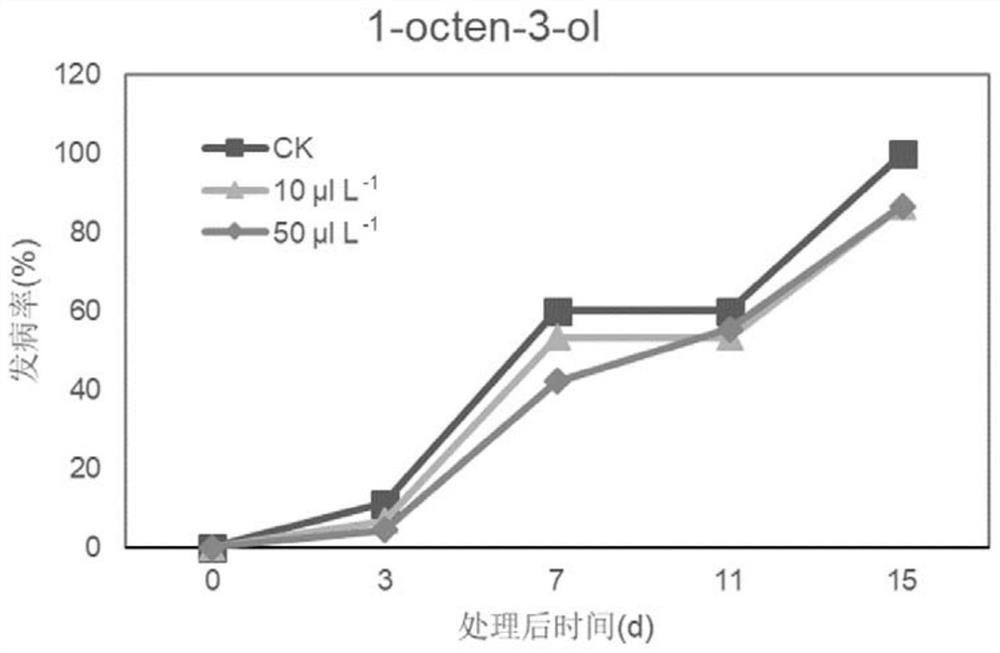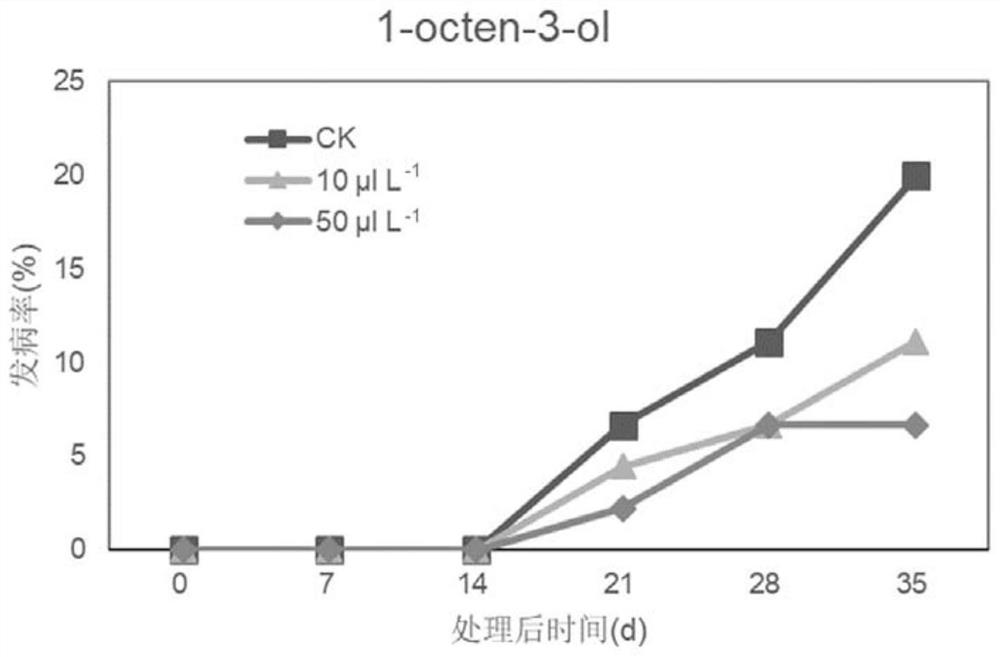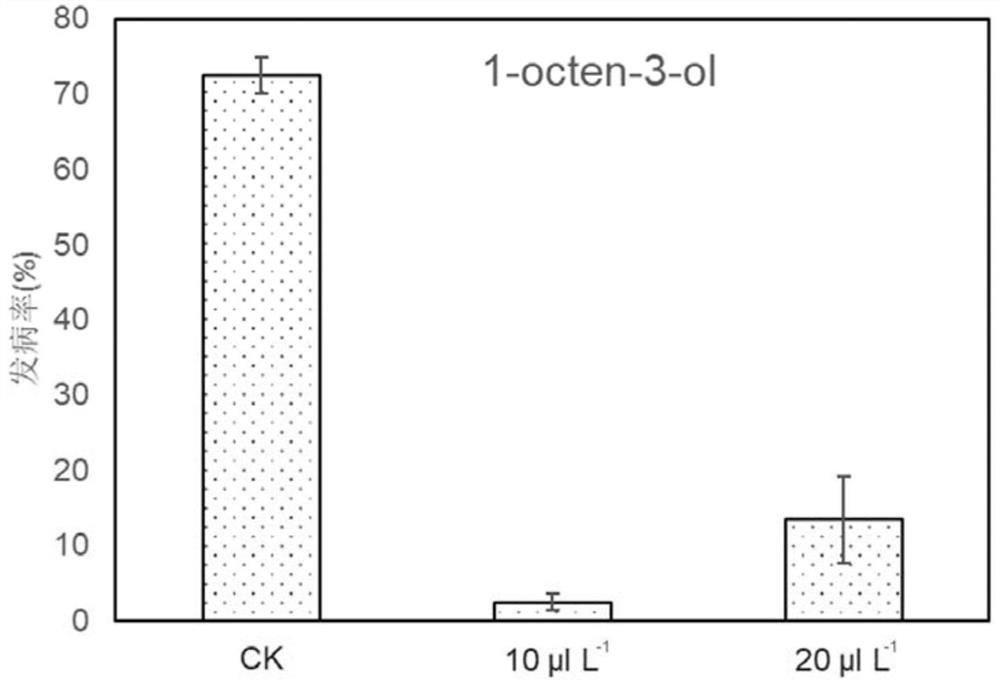Application of 1-octylene-3-alcohol in prevention and treatment of postharvest diseases of fruits
A fruit postharvest disease, octene technology, applied to the application of 1-octen-3-ol in the prevention and treatment of fruit postharvest disease, 1-octen-3-ol field, can solve the problem of unreported application , to achieve the effect of inhibiting growth and good control
- Summary
- Abstract
- Description
- Claims
- Application Information
AI Technical Summary
Problems solved by technology
Method used
Image
Examples
Embodiment 1
[0027] Example 1. Effect of 1-octen-3-ol on postharvest rot of Actinidia jujube
[0028] experiment material:
[0029] The kiwi fruit (Longcheng No. 1) with uniform size, no disease, and eight matures from Dandong, Liaoning was selected. 1-octen-3-ol is domestic analytically pure.
[0030] Research methods:
[0031] Different concentrations (10 and 50 μl L -1 ) 1-octen-3-ol was fumigated for 2 days, then packed into small packages of 3 boxes each, and the natural onset was observed under low temperature and normal temperature conditions respectively. Measure once every 2 days under normal temperature conditions, and measure once every 7 days under low temperature conditions. 45 fruits per treatment.
[0032] Research result:
[0033] 1. The control effect of 1-octen-3-ol on the rot of Actinidia jujuba at room temperature
[0034] The result is as figure 1 shown. Depend on figure 1 It can be seen that under the condition of normal temperature, the disease of kiwifruit...
Embodiment 2
[0037] Example 2. Control effect of 1-octen-3-ol on postharvest blue mold and gray mold of Actinidia jujube
[0038] 1. Materials and methods
[0039] (1) Test material
[0040] The kiwi fruit (Longcheng No. 1) with uniform size, no disease, and eight matures from Dandong, Liaoning was selected. 1-octen-3-ol is domestic analytically pure. The expanded Penicillium and Botrytis cinerea are preserved by our research group.
[0041] (2) Fruit inoculation
[0042] Pick kiwi fruit with consistent maturity and no mechanical wounds. First use 2% sodium hypochlorite solution to soak and disinfect the fruit. After rinsing with tap water, stab a wound with a diameter of 3 mm and a depth of 3 mm at the equator of the fruit, and wipe off the overflowing juice. Inoculate each wound with 5 μL at a concentration of 1 x 10 5 Individual / mL Penicillium or Botrytis cinerea suspension. Put the inoculated kiwi fruit into an 8L lock box, and use different concentrations of volatile antibacter...
Embodiment 3
[0048]The influence of embodiment 3,1-octen-3-ol on the growth of Penicillium expansum and gray mold Botrytis cinerea
[0049] 1. Materials and methods
[0050] (1) Test material
[0051] 1-octen-3-ol is domestic analytically pure. The expanded Penicillium and Botrytis cinerea are preserved by our research group.
[0052] (2) Research methods
[0053] Inoculate Penicillium P.expansum and Botrytis cinerea B.cinerea on PDA plates, treat the two pathogenic bacteria with different concentrations of 1-octen-3-ol under airtight conditions, cultivate them at 25°C, and detect the colony diameter every day.
[0054] 2. Research results
[0055] 1-octen-3-ol has a significant inhibitory effect on the growth of P.expansum and B.cinerea, and the minimum inhibitory concentration is 20μl L -1 and 10 μl L -1 , can completely inhibit the growth of two pathogenic bacteria.
[0056] From the above experiments, it can be seen that:
[0057] (1) The 1-octen-3-ol fumigation treatment can s...
PUM
 Login to View More
Login to View More Abstract
Description
Claims
Application Information
 Login to View More
Login to View More - Generate Ideas
- Intellectual Property
- Life Sciences
- Materials
- Tech Scout
- Unparalleled Data Quality
- Higher Quality Content
- 60% Fewer Hallucinations
Browse by: Latest US Patents, China's latest patents, Technical Efficacy Thesaurus, Application Domain, Technology Topic, Popular Technical Reports.
© 2025 PatSnap. All rights reserved.Legal|Privacy policy|Modern Slavery Act Transparency Statement|Sitemap|About US| Contact US: help@patsnap.com



